See likes given/taken
| Post info | No. of Likes |
|---|---|
|
"The cake is a lie" - exhibition at Finnish Museum of Games
An exhibition about video game food culture has opened at Finnish Museum of Games and like mentioned earlier UnReal World is featured and involved in the exhibition - and in the additional downloadable content. So, let's break it down. "The cake is a lie" exhibition is on display at Finnish Museum of Games 24.1.2021 – 31.8.2021. In addition to physical exhibition there’s also an additional downloadable content - .pdf publication dealing with the topic in more detail. In the publication you can find a whole UnReal World menu to try out, and quite an interesting interview too. And of course more about the other themes and games in the exhibition. There’s currently only finnish version of the publication available, but translated edition is coming up. We’ll let you know when it’s available, but for starters here’s exhibition briefing and .PDF download link in Finnish: http://vapriikki.fi/pelimuseo/studio/ http://vapriikki.fi/content/uploads/2021/02/kakkuonvale_julkaisu_A5_korkearesoluutio.pdf (There are some delicious images to browse even if you wouldn't understand the language.) And here’s the exhibition briefing in English: http://vapriikki.fi/en/pelimuseo/studio/ Now this an exhibtion to visit if you happen to be around Tampere, Finland. For finns, here’s curator’s say about the exhibition. It’s really interesting and delicious summary. https://www.youtube.com/watch?v=eqA06pNmWN4 Now go have a look if possible - or enjoy the publication. Thanks and respect for the Finnish Museum of Games and organizers for the exhibition. It was a pleasure to participate, and I like to outcome very, very much. We'll let you all know when translated publication is available for download. February 11, 2021, 09:41:21 AM |
1 |
|
Auto-cutting and other tying equipment additions
Bunch of tying equipment related additions are being worked on. It's a sector of code where meandering from one feature to another is quite easy, and sometimes required, but these main blocks are on the table right now: * Auto-cutting tying equipment to required lengths in crafting/building. For example: If you'd need say 5 feet of cordage and select a 15 feet rope for the job it's auto cut to required length and the remaining portion (10 feet) stays in your inventory. With this new condition in effect the cordage minimum lengths however will come into play. So with the above example you need to select 5 feet long cordage minimum, and would need to join the cordage manually first if only shorter pieces are available. In any case it makes more sense, and is less of micro-management, than the current system. * Few cordage classifications as crafting requirements Currently the actual tying equipment properties aren't that much checked in crafting processes. Almost any tying equipment works for any job. Now we'll see about adding a few requirement classifications such as "strong cordage", "thin cordage" or "thread". These would work so that for example "strong cordage" requirement accepts ropes and spruce withes - which are the strongest type of withe. Crafting for example a raft would required "strong cordage" for tying, and now you could use ropes and spruce withes that, but not the other kind of cordage outside the classification. Arrow making would require "thread" type cordage. Loop snares could be only made from "thin cordage". And so on. Classification is still under construction so different wordings can be suggested, and ideas posted here. It's can be quite tricky to find terms that would open up easily, and not to end up with too many categories. Naturally the game will also display messages about this-and-that requirement accepting this-and-that items. Strong cordage - ropes, spruce withes Thin cordage - strings, cords Thread - yarns (or sinew threads, whenever we get there) etc. * Nettle processing We'll add the steps to be able to make nettle yarn, and then see where it goes after it's working ok. In addition to retting and beating the fibres out of the stems, there would be preferably also the easy early summer method where you can extract the fibres by hand and make primitive yarn fast - eg. for survival fishing rod line. February 15, 2021, 01:29:40 PM |
1 |
|
Into the Iron-Age eating habits the Finnish Museum of Games shall take you
An exhibition about video game food culture has opened at Finnish Museum of Games. UnReal World is featured in the exhibition in many ways ... ... and the most delicious parts are now served to you within a special downloadable content which is now available also in english. The Cake is a Lie exhibition is on display 24.1.2021 – 31.8.2021 at Finnish Museum of Games, Tampere, Finland. Even though visiting the physical exhibition is not a possibility for most of us everyone can still get a good taste of it with downloadable publication they have made available. Deep and delicious downloadable content From Screen to Plate is an expansion, or DLC to the exhibition. This downloadable .pdf publication explores the writing of videogame food blogs and books, glances at cooking simulators, and marvels at UnReal World’s Iron Age eating habits through an interview and an entire menu to try out. UnReal World menu is based on the actual dishes you can cook in the game, but now with the recipes and instructions printed out you can try cooking them for real. In the interview Sami talks about the food and its meaning in the game, also covering historical viewpoints and folklore behind the game mechanics. What kinds of rituals were involved in eating during Iron-Age? Which UnReal World foods the dev himself would like to try out? Would players find the game’s food tasty? You can download the publication from the links below. There's English and Finnish edition available. "The Cake is a Lie - from Screen to Plate DLC" (in English) "Kakku on vale - ruudulta lautaselle"-julkaisu" (in Finnish) 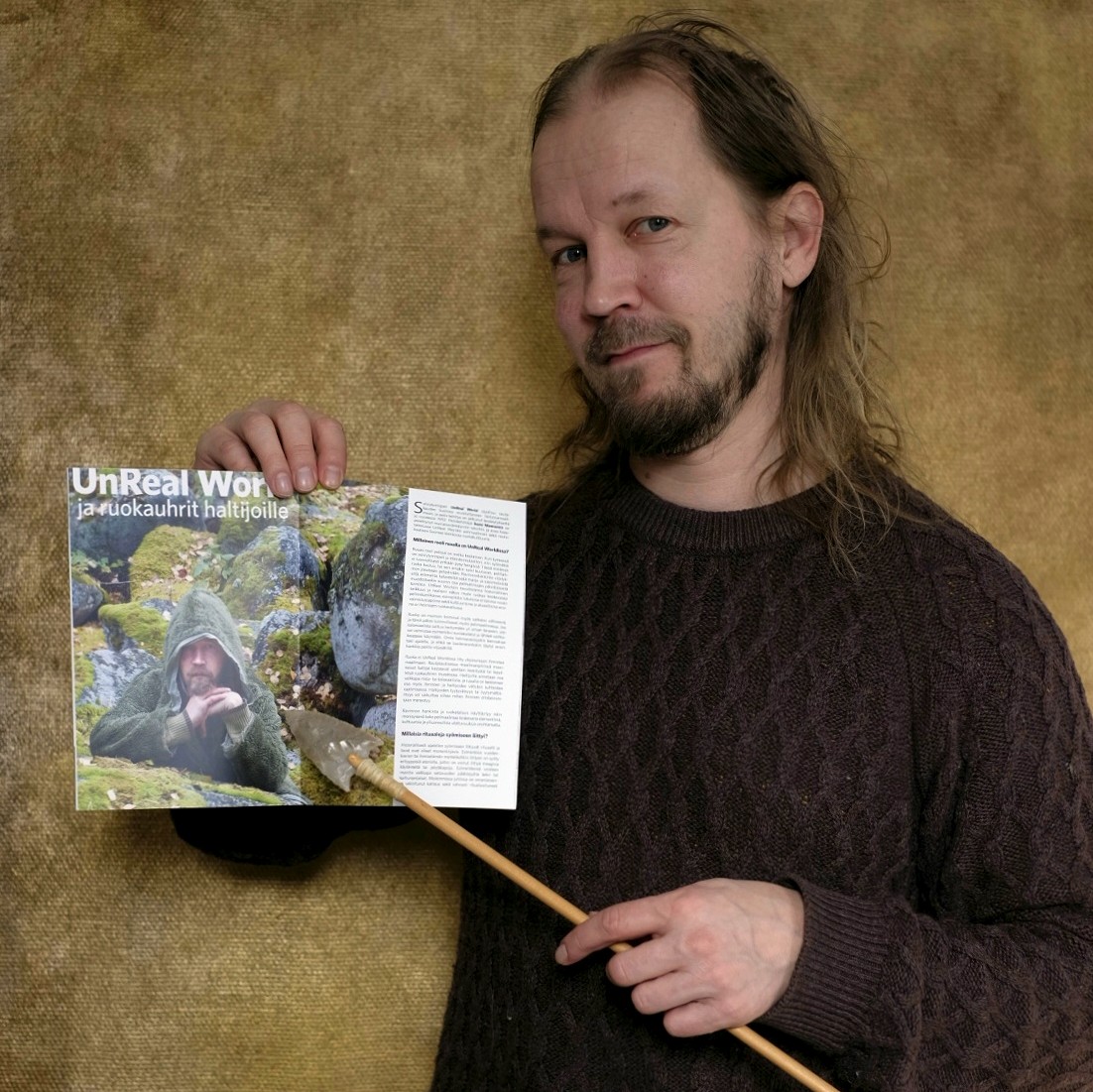 The publication is also available as printed A5 booklet for those who have an opportunity to go see the physical exhibition. Cheers! Keep on roasting in the free world... March 07, 2021, 03:34:20 PM |
1 |
|
'Asentokuusi' - simple shelter under a leaning spruce tree
A few essential wilderness accommodation options for rough wanderers are coming up. 'Asentokuusi' (can be freely translated as "post spruce") was the simplest form of shelter for resting and spending a night protected from the elements - and in the next patch we'll be featuring a possibility to set up a 'post spruce'. Post spruce is made simply by felling a young spruce to lean against another spruce tree. Some of the lowest twigs are removed to create space, and these are then laid on the ground for some insulation and cushion. Simple as that. This was the usual method of spending a night in the wilderness condition when more permanent camp wasn't necessary. Setting up a post spruce will found in "Building options", and it does felling the tree and covering the ground with twigs all together. Tools needed for the process are the same as for felling young trees in general. With this addition we'll also feature general usage of spruce twigs as ground cover for insulation. If there are no furs to cover yourself into sleeping on spruce twigs, instead of bare ground, now keeps you a bit more warm during cold nights. These are future additions, not yet functional in current version 3.63. March 12, 2021, 06:39:15 PM |
1 |
|
Textilecraft continued
Fibre processing is on the table. We'll be featuring a new skill, TEXTILECRAFT, which determines the success and time required for several work phases of processing fibres into yarn. For migrated characters textilecraft will be initiated to the cultural defaults upon first load. All the textilecraft options - retting, drying, spinning etc. - will be found in the general [M]ake menu, and can be also accessed simply by using the skill. Spinning fibres into yarn is now pretty much competely done, the productions times and yarn yield carefully considered. Textilecraft mastery, and using a spindle or not, naturally affects to outcome and spinning times. The actual mechanics of getting fibres spun works so that when "spin yarn"-textilecraft option is chosen you'll be asked to choose from the inventory which fibres to spin. After that you'll be informed how much yarn you can expect to get from that, and can select how much you wish to produce now. And then the spinning starts, with a spindle or by hand. During the playtest I've spun (magically generated) nettle fibres, but we'll be also making hemp as fibre source. The fibre processing keeps track of the master plant so the plant identity is easily turned into resulting yarn. Nettle yarn, hemp yarn, and so on. Flax is naturally something to think of. We'll see if it fits into this version. Now as the yarn generation from the fibres is working we'll be also adding yarns as village items, so instead of spinning your own you can also trade your yarn from some cultures. The big question still being pondered is how expensive yarn should be? It's hard work to spin yarn with a spindle, takes about minute to produce three feet (or a meter). Next up, coding and testing the preceeding steps; retting and drying and extracting fibres. A few screenshots follow. 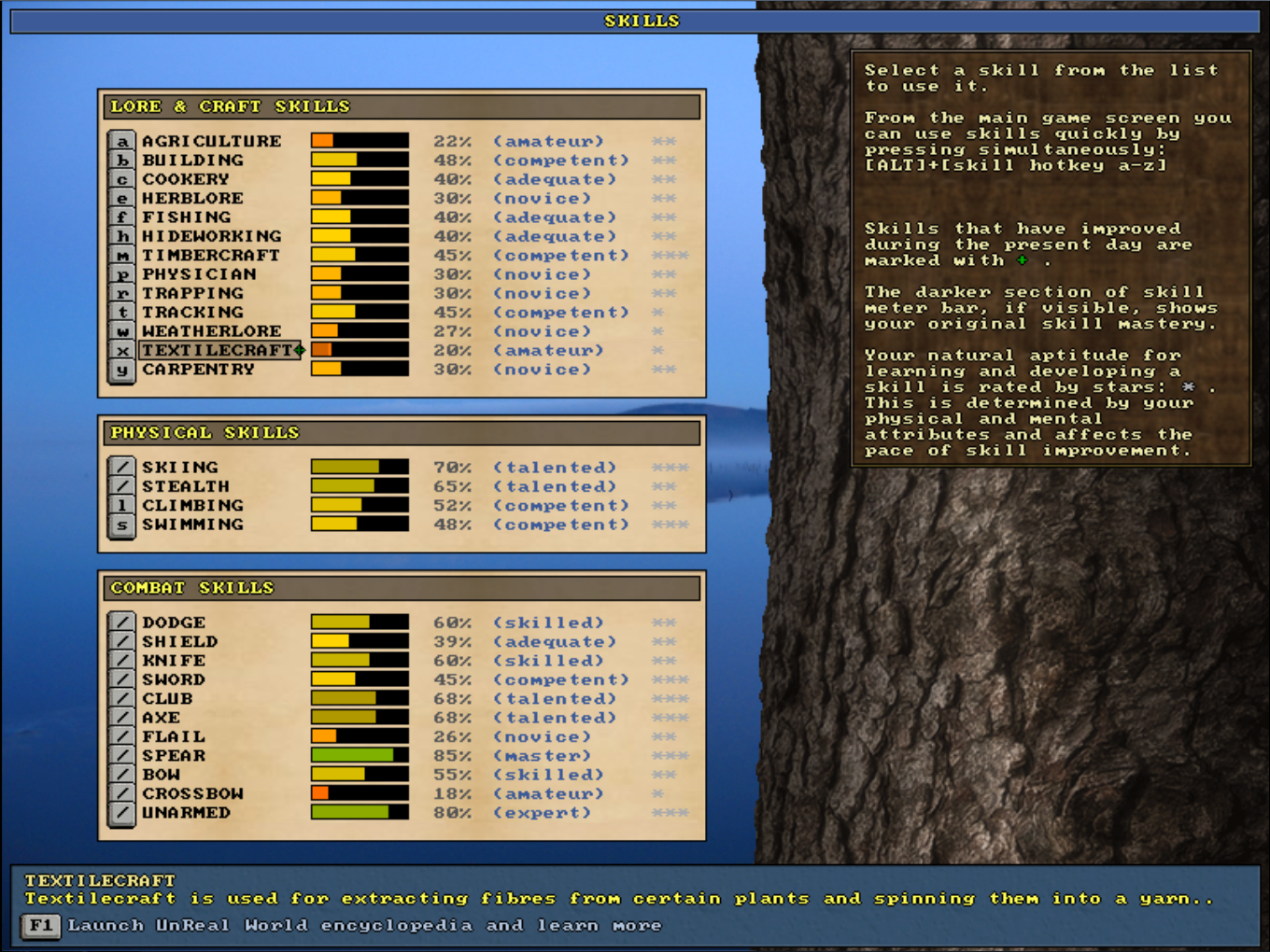 Skills screen with TEXTILECRAFT in place. 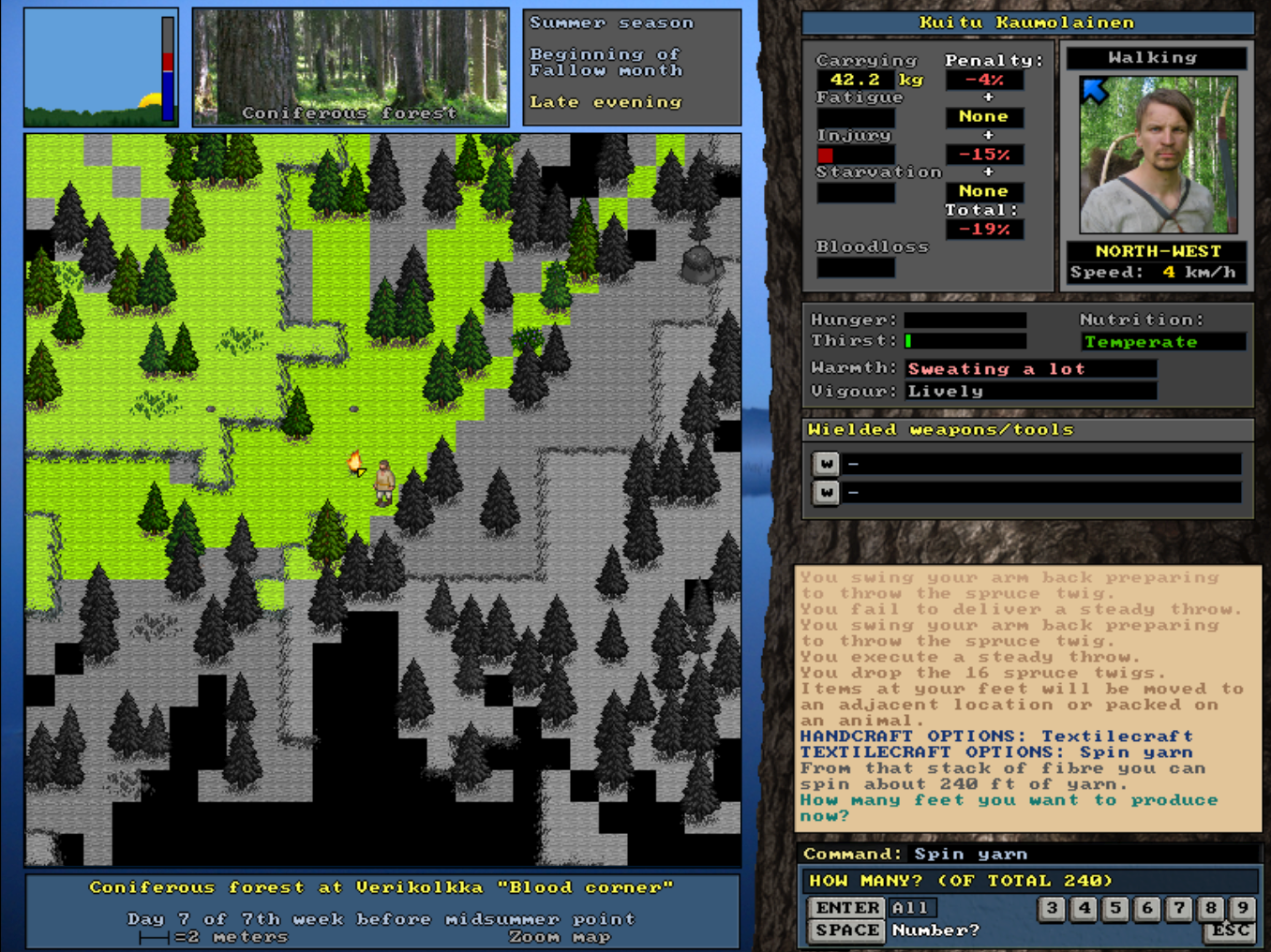 After choosing the bundle of fibre to spin there's dialog asking how much of yarn Kuitu Kaumolainen wishes to produce on this go. March 24, 2021, 07:08:44 PM |
1 |
|
The Moon and The Crust
Erkka was visiting me last weekend and some really exciting weather engine achievements and accompanying real life adventures were made. Now there are two new essential weather features on the table - both still somewhat under construction, but most likely to be seen in the next version. And the features are... * The moon. Our weather engine now models the moon in detail, with its' changing phases and moonlight affecting to the nighttime visibility and brightness. Lots of tuning is still pending, but we can already see that the full-moon nights in the game will be a different experience. Especially during the darkest seasons moonlight can be a of great help and extended the available hours for working, hunting or travelling. Just have a look at the screenshot compilation below. 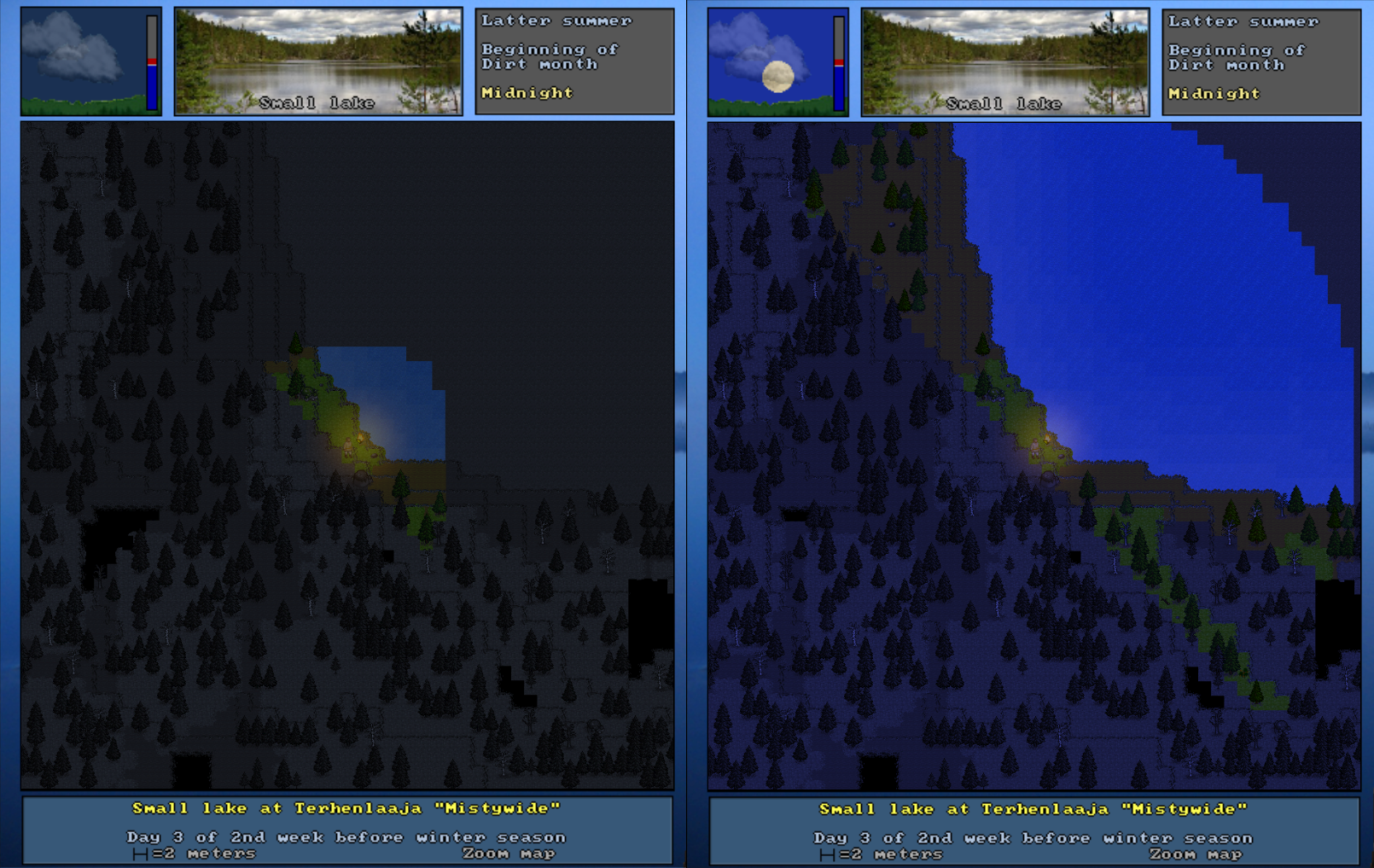 Left: A casual midnight by the lake in dirt month as it appears currently in the game. Right: The same scenery with the new moon code in action. It's full moon and our nighttime visibility is a much different. * Snow crust Snow crust is a springtime phenomena where surface of the snowpack becomes so hard that it can completely support a walking or skiing person. The crust results from partial melting of the snow surface by warm spring day sunlight followed by re-freezing when the temperature drops again, usually after the sunset. The crust normally only lasts for part of the day, but being able to travel on snow without sinking in there at all is a great asset for a hunter. Elks were traditionally hunted on skis during crust as it can't support the heavy animals and hunter gliding on crust with skis now became much faster than their prey. Lots of work is still needed before snow crust support is all coded, but that's the intention. Now it also requires proper snow penalty to be added for NPCs and animals, and reworking the skiing code to some extent too. (And if you were thinking of skiing NPCs so were we.) The last weekend it was both full moon and snow crust possibility, so we also went experiencing these things in real life. Naturally these both are familiar experiences already, and as countryside kids we've learned possibilities of snow crust for work and leisure all the way from our childhood. But if you'd like to see the magic of skiing in moonlight without any artificial light, or get an idea about difference between skiing in slushy spring snow compared to the crust, we've got a short videoclip for you: https://www.youtube.com/watch?v=JOcb_cm5UkE March 29, 2021, 05:36:42 PM |
1 |
|
Fibre processing done
So, the system of processing fibres from hemp and nettle into yarn is now all coded. Small adjustments remain, but we've happily accomplished mechanics for all the work phases and necessary adjustment to data structures. Adding this system of textilecraft has been likely the most laborous single feature to code in the upcoming version. With several other features regarding tying equipment we can talk about sort of cordage overhaul. Soon enough I'll be posting more organized entry about the whole system with screenshots, but now let's quickly cover what hasn't been covered in the earlier textilecraft news. So, the final two additions to textilecraft system were drying the retted plants and the actual extracting of fibre. Drying is simplified. It takes about a week for retted plants to dry before extracting the fibre can be proceeded. And you can basically set them drying anywhere. The idea of extracting the fibres is to break the dried retted stalks so that the woody core shatters and falls away leaving the loose fibres free. Traditionally this was done with a special device called ‘loukku’, but in the game we use more primitive method of beating the stalks for example with a club on a solid working surface. The requirements are similar to softening hides as a last step of tanning; beater and a working surface. Extracting fibres is hard physical work and commonly carried out with several people working together. If you have companions around they will help you with the task. After the breaking phase, obtained bundles of fibre are scraped free from remaining coarse parts and extraneous material. This is done in steps, first removing the biggest extraneous parts and gradually proceeding towards the finer ones. Traditionally special tools, combs and brushes were used to clean the bundles of fibre as effectively as possible. In more primitive fashion it can be also done by whisking, rubbing and whacking the bundles against a hard surface, or with tools at hand. In the game this is the method used, and the equipment available for breaking is applied here as well. All these required phases are done with single textilecraft option. Extracted fibres are obtained in small bundles, eg. "bundle of hemp fibre". These items are categorized as PLANT type in character's inventory. As mentioned before, nettle fibres can be also extracted directly from the stalk by hand even without retting. Although it's slower to mass produce fibre that way it can be useful option when only a small amount of fibre is needed. To do it, simply use extract option directly to freshly harvested nettles. The nettle stem is crushed by hand, and the fibres carefully stripped off. Character's expertise in textilecraft affects to required working time and amount of usable fibre extracted. So as your mastery in textilecraft increases you can expect to get higher fibre yield in shorter time. These are future additions - not yet functional in current version 3.63. May 06, 2021, 04:19:40 PM |
1 |
|
Sneak preview of textilecraft system with screenshots and additional insight
Time for a little sneak preview with our textilecraft test character Kuitu Kaumolainen. Some of the stuff mentioned here has been mentioned before, but a summary about textilecraft is in place now. With some sdditional insight and sidetracking included. So, the biggest single addition to the upcoming version is featuring mechanics to extract fibres from certain plants and process them into yarn. For this, a new TEXTILECRAFT skill was created, and lots of spin-off features regarding fibre processing and cordage also followed. Fibres can be extracted from nettle, hemp and flax - which has been added as a new cultivated plant. Let's start from there ... Flax Flax is an old cultivated textile plant, but in Iron-Age Finland it wasn't even as commonly grown as hemp. One reason for this is that flax doesn't survive in the very north so in the game it's grown only by certain cultures south of Kaumo. As a curiosity, the finnish word for flax ('pellava') originally meant the nettle plant ('nokkonen') which speaks about importance of this age-old wild source of fibre. But nevertheless, flax is in the game now and it can be grown, harvested and processed for fibre. 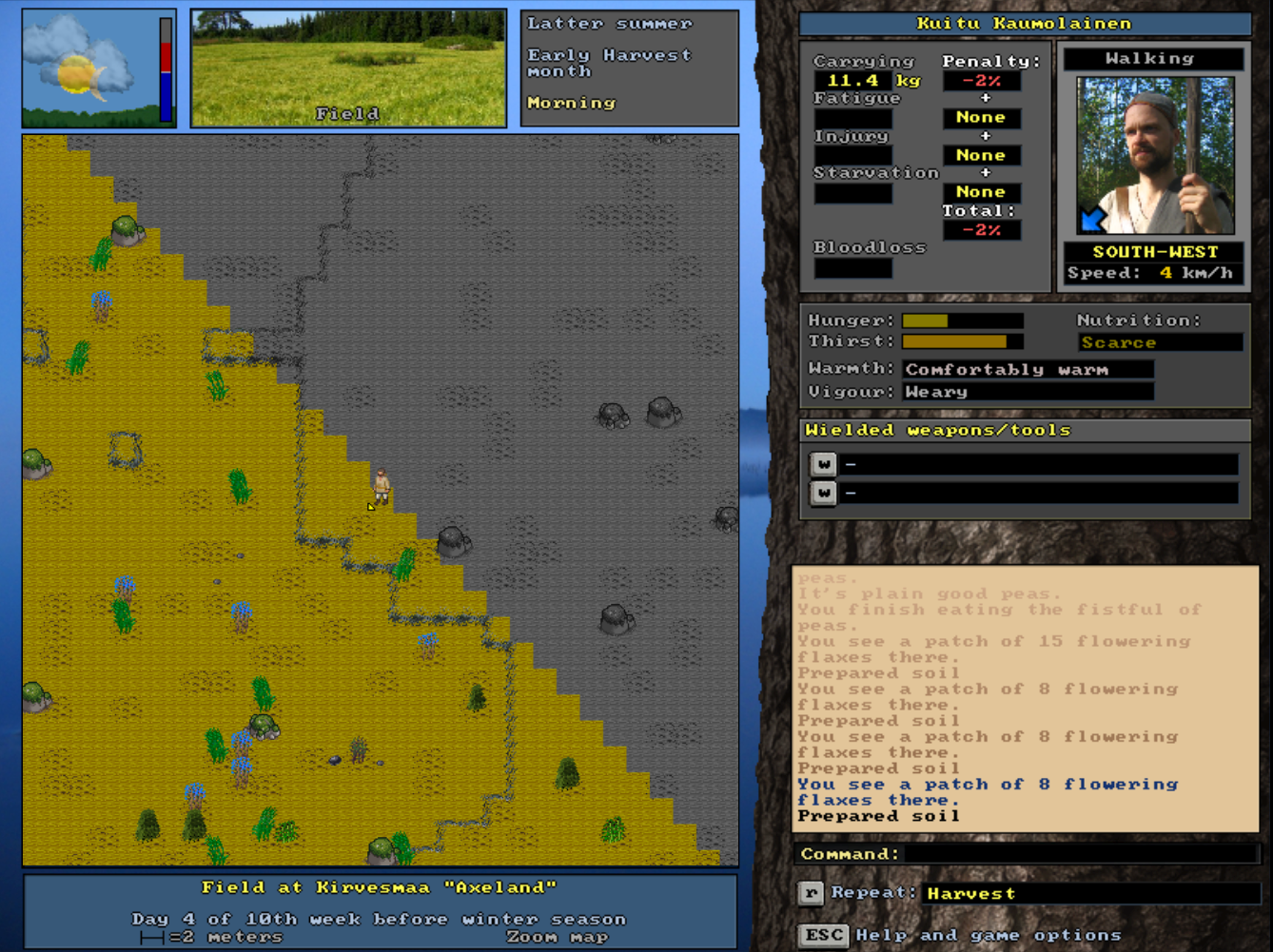 Kuitu Kaumolainen has found his way to Kiesse, a region where flax is grown. At Kaumo where he's from they only produce nettle or hemp fibres. Blue flowering flax is easily spotted from the field, and it could be harvested for fibre already. Textilecraft options Processing plant fibres into yarn involves several stages of work, and it's all done by using your TEXTILECRAFT skill. Character's expertise in textilecraft affects to required working times and the amount of usable fibre or yarn produced. After the plants are harvested the fibres must be then separated from the plant's stalks. This process is called "retting", and it is done by soaking the plants in the water for several days. Sufficient soaking time depends on the water temperature, with the warmer being faster. 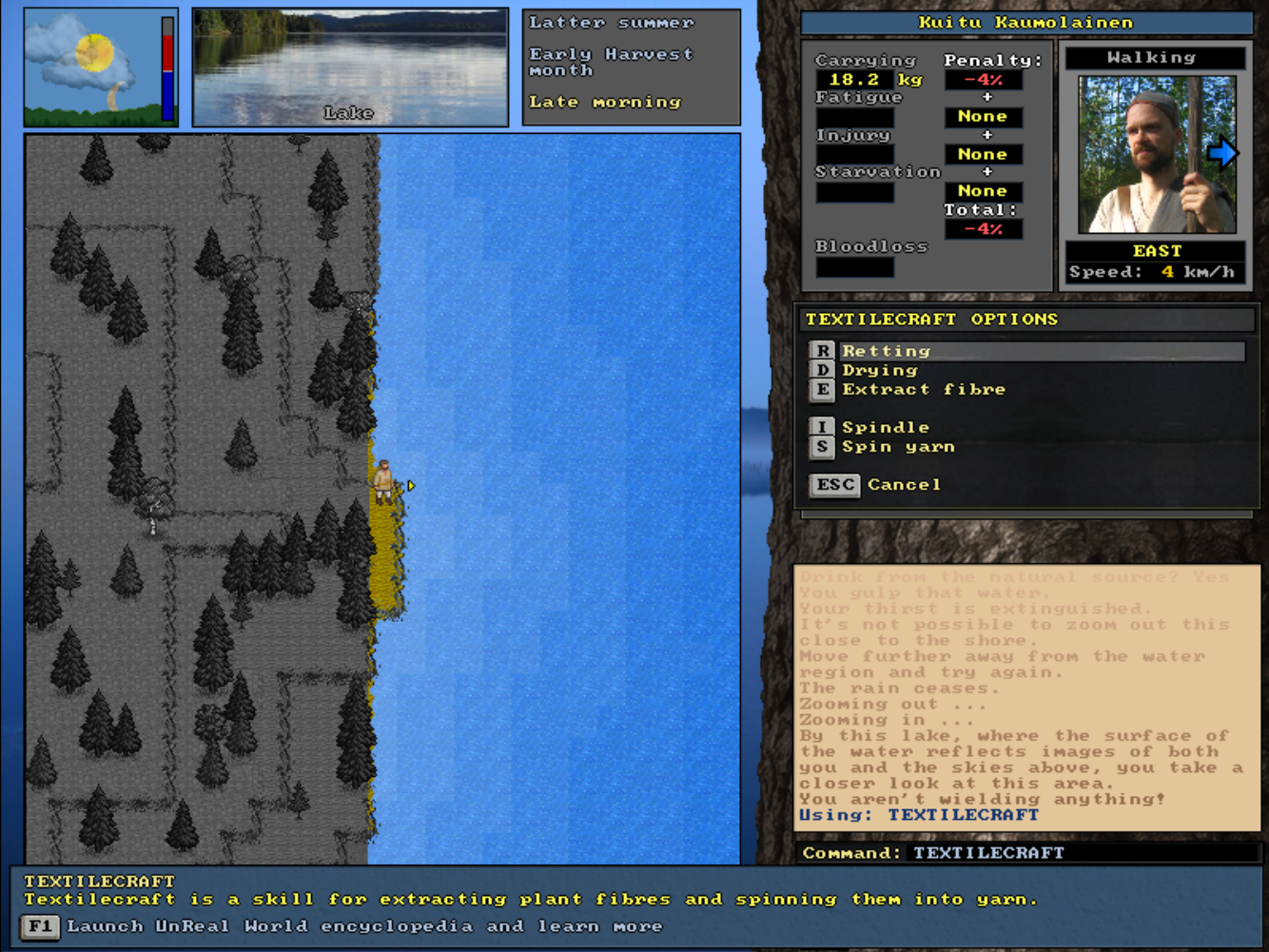 Kuitu Kaumolainen harvested 100 flaxes and headed by the lake to start retting the stalks. Here you can see all the textilecraft options to proceed with fibre extracting and spinning them into yarn. Extracting fibres is hard work It took two weeks for Kuitu's flax to soak properly. After that it took one more week to dry them. And only then Kuitu can start extracting the actual fibre from the stalks. Extracting fibres is done by breaking the dried retted stalks so that the woody core shatters and falls away leaving the loose fibres free. The stalks are beated for example with a club on a solid working surface. Extracting fibres is hard work and commonly carried out with several people working together. Traditionally there has been a custom to arrange specific work parties for processing fibres of each village together with the neighbouring people. And in the game your companions can actually help you with the task. Obtained bundles of fibre are then scraped free from remaining coarse parts. Traditionally special tools were used, but it can be also done by rubbing and whacking the bundles against a hard surface, or with tools at hand. 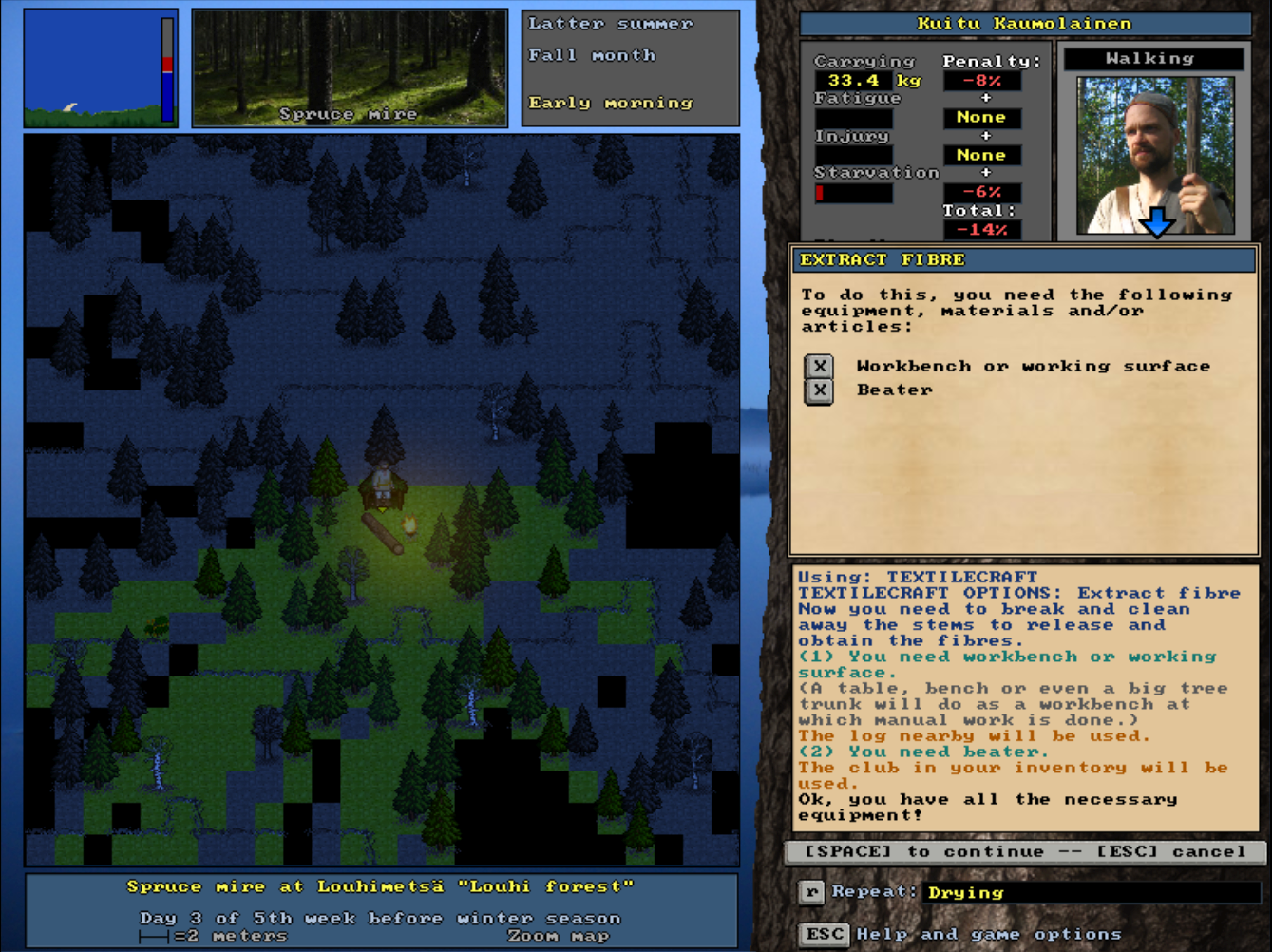 Kuitu starts extracting fibres from the dried retted flax stalks at his shelter. He is about to beat the stalks with a club on top of a log. These dried retted stalks could have been also stored for future and the fibre extracted when there's time and need for that. Spinning yarn It took lees than half an hour to extract the fibres from his 100 flax stalks and Kuitu got 16 bundles of flax fibre. Fibres can be then spun into yarn either by hand, which is slower, or using a spindle. Spindle is also a new craftable item, and very easy to make. So Kuitu crafts a spindle and starts spinning. He decides to go for full length yarn. When starting spinning it is possible to choose how long yarn you wish to spin on one go. 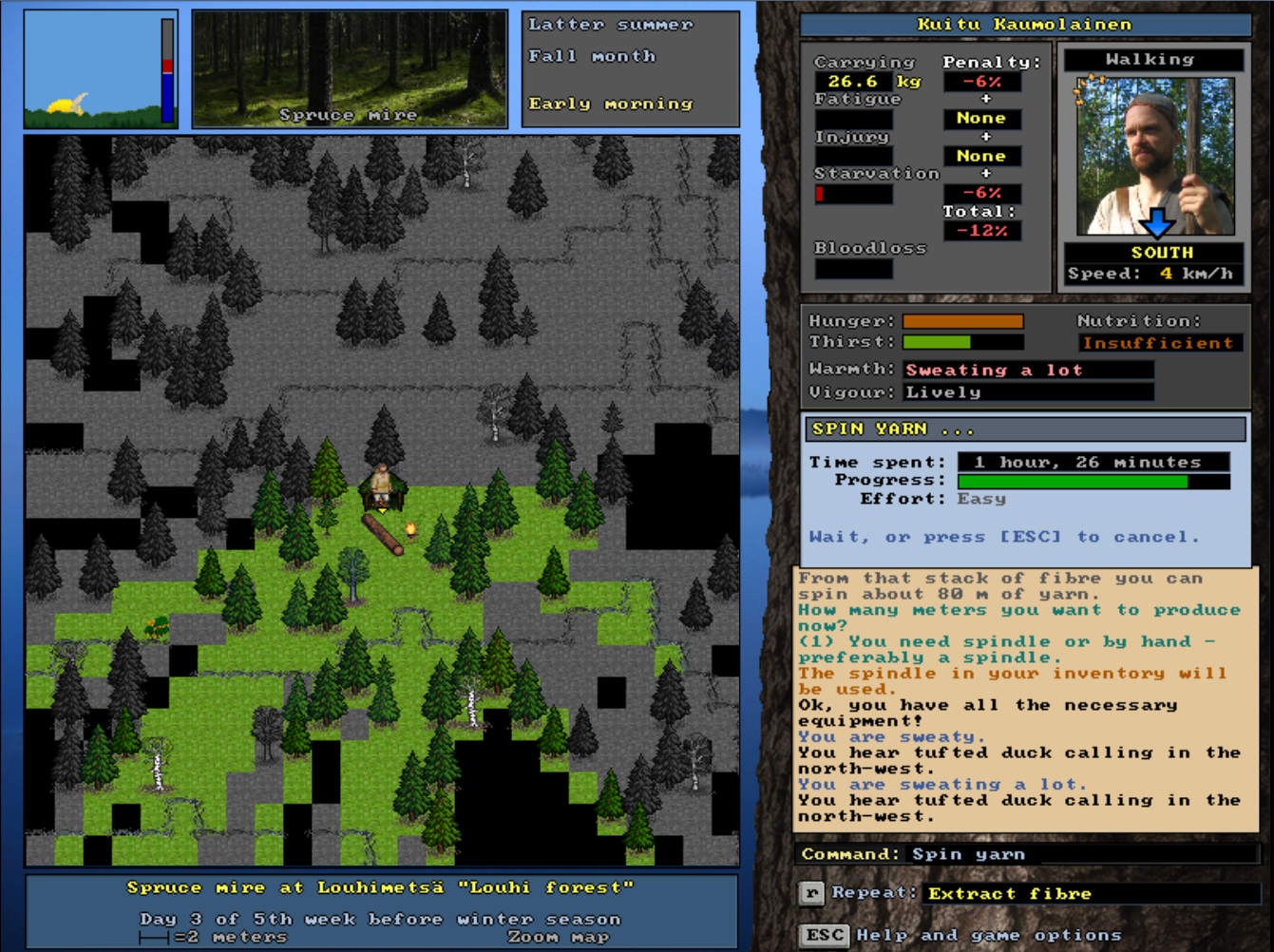 Kuitu manages to spin 80 meters of linen yarn in less than two hours. It could be then used in crafting of different items such as loop snares, arrows - or fishing rods. Nettle specialities In the next version it will be also possible to craft fishing rods, and hooks out of wood or bone. And a working fishing rod naturally needs a line too. Now Kuitu has his linen yarn which could be used as line, but the whole process of extracting flax fibres with retting and drying took weeks. That's quite a long time if there's an urgent need for little piece of yarn. Luckily there's also faster wilderness condition option for utilizing plant fibres - and that is a nettle. Nettle fibres are a speciality as they be extracted directly from the fresh plants without retting and drying processes. To do it you can simply use "extract fibre" option directly to freshly harvested nettles. This method takes more time, but is an useful option when only a small amount of fibre is needed. The nettle stem is crushed by hand, and the fibres carefully stripped off. It doesn't take long before Kuitu finds some nettles. Textile plant harvesting is made possible for fibre even when they are still growing. 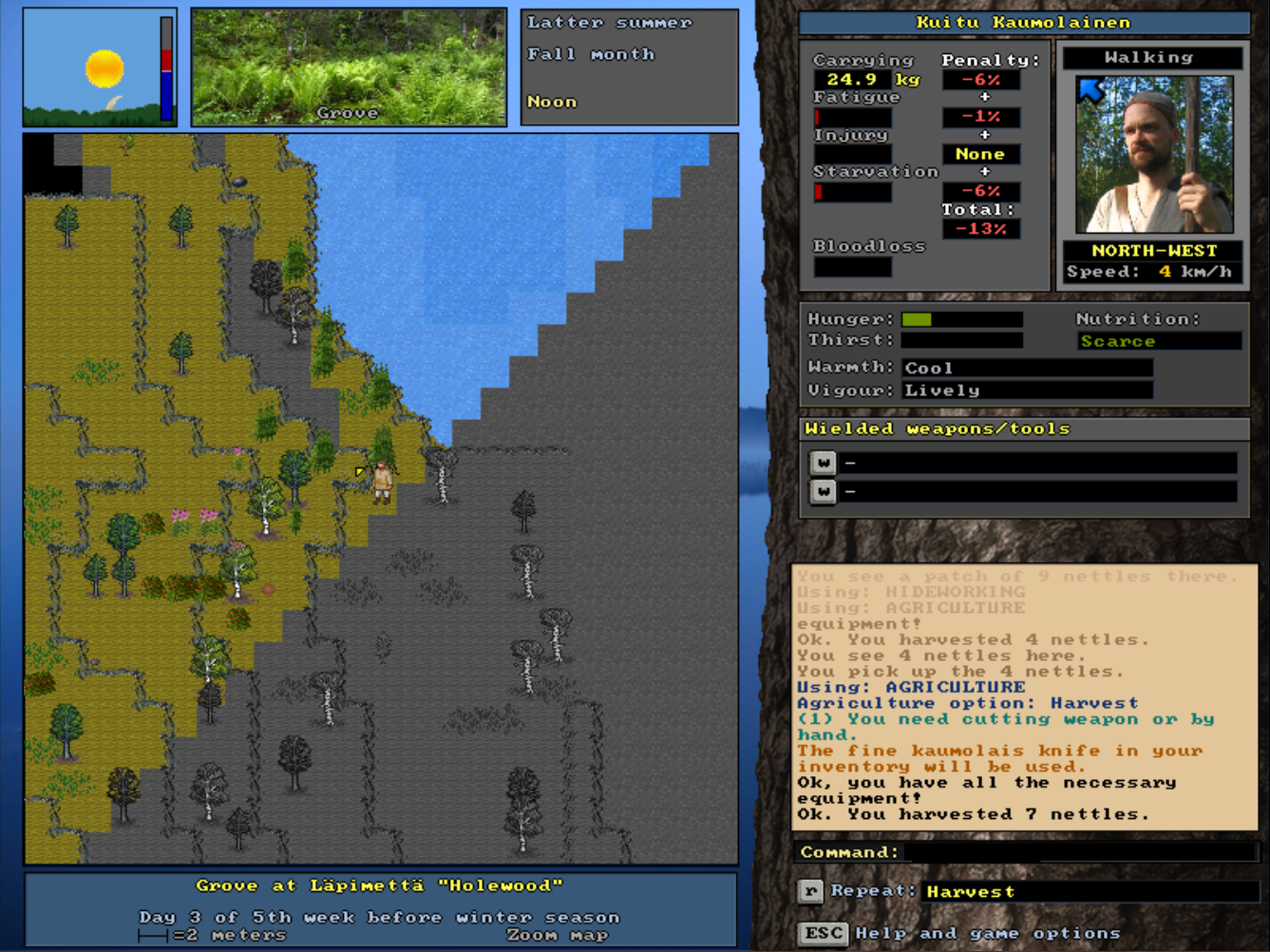 Kuitu harvests some nettles. Then he simply extracts the fibres by hand, and spins some nettle yarn. If he would like to produce a lot of yarn, this would be too slow to be practical, but now he's only after fishing rod line, Wooden hook, nettle yarn - and baits Kuitu finds a slender tree trunk, fashions a wooden hook out of a branch, and proceeds to assemble a fishing rod. Now we should mention that In the upcoming version usage of baits in fishing is also featured. Using baits is not necessary, but naturally highly recommended. Catching a fish every now and then without a bait is still possible, but for reliable rod fishing and decent catches baits are now quite essential. You can use pretty much every food item as a bait and portion of the selected item will be used during the fishing attempt. Pieces of raw meat and fish can be considered decent baits for predatory fish, but for example crumbs of bread may also work for some fish. You can also use a whole small fish, eg. roach or perch, in order to attract a bigger predatory fish. With this addition in effect the type of fish caught with rod fishing is now more dependant on the baits used. It's not likely that you'll catch a pike with an empty hook, but having a small roach as a bait might work. And that little roach might have been caught with quite moderate bait such as bread crumb, or even with some tasty vegetation. 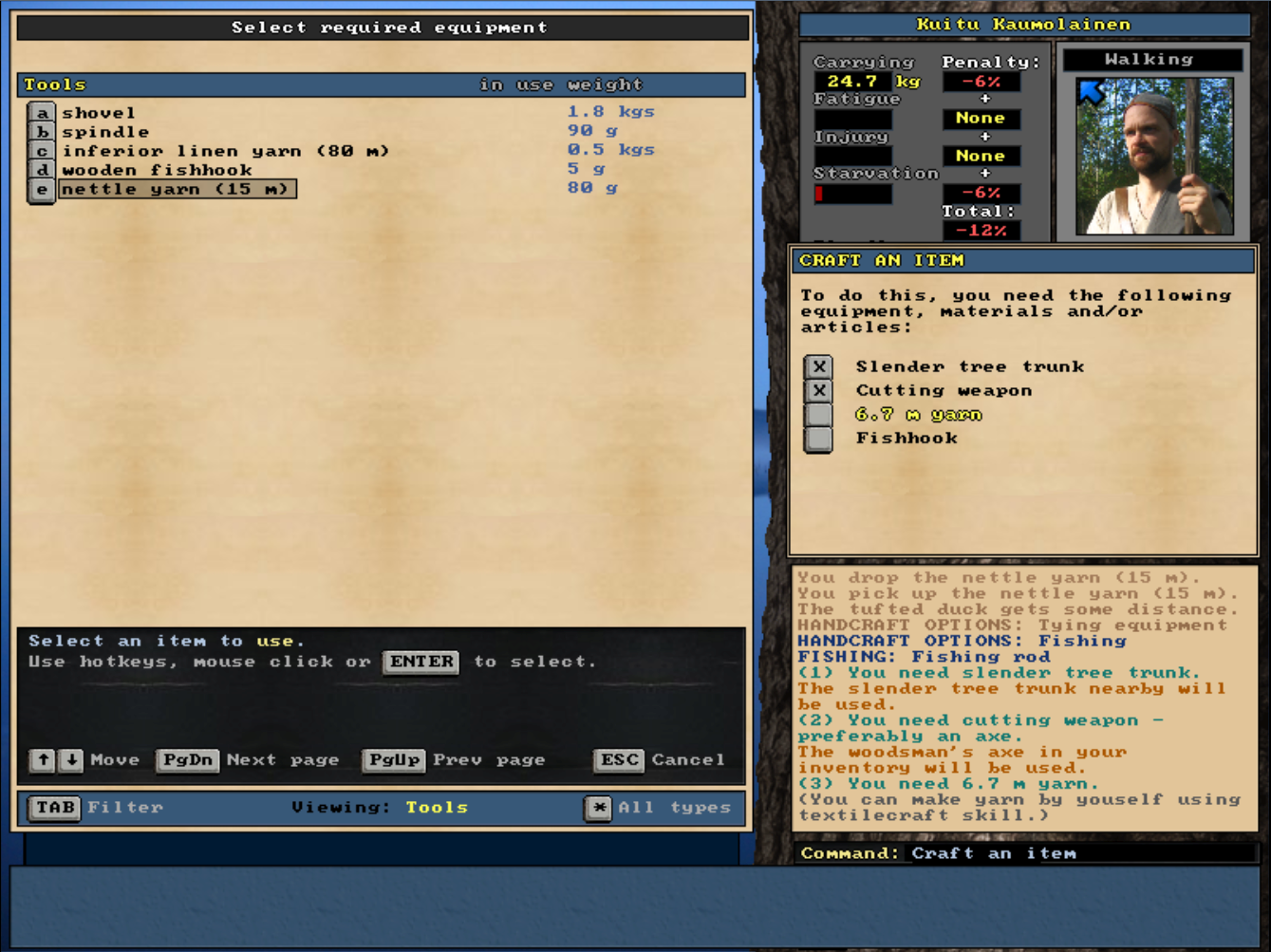 Kuitu makes his survival fishing rod, with a wooden hook and nettle yarn. The work with the several less laborous features continues but we're getting closer to release every day. It's always quite impossible to say when everything is completely wrapped up and working, but maybe - just maybe - we might have this version out in june. Cheers! For those who are more curious about the real life practises here's a short documentary in Finnish showing how the flax is processed. Having read the above I trust you will understand what is happening even without subtitles. The gear used differs slghtly from the more primitive method of the game, but the steps are the same; sow, harvest, ret, dry, extract, spin. https://www.youtube.com/watch?v=TNFD_CUlxZU May 11, 2021, 03:52:38 PM |
1 |
|
...and snow penalties for all
Back at snow code. A good while ago we added the snow crust to weatherengine. Its' working game mechanics in character's life are still pending to be added, and so are the skiing NPCs. Both are coming up, but before that these improvements were first in line. - improved: moving in the snow mobility and fatigue penalties Previously there was one overall reduction to character's mobility when moving in the snow without skis, but now the actual snow depth affects to how much the mobility is actually reduced. The same goes for fatigue as it now accumulates slower or faster depending on the snow depth. Shortly, the deeper the snow the harder and slower it is to trudge through it without skis. - added: snow penalties for animals and NPCs NPCs and animals now suffer from the snow penalties similarly to player character. All the snow penalty mechanics now work the same for player character, other human beings and animals. The actual snow depth that starts to hinder the animals is naturally relative to their size. A human knee deep snow is a little extra strain for an adult elk, but for example a wild boar or dog would suffer from it more significantly. The new snow depth mechanics bring in many new factors to animal movement and hunting scenarios. For example, it now becomes actually possible to practice traditional hunting tactics to more easily chase elks on skis during the deep snow period. It should be noted that there also several animals that are adapted to moving in the snow without much difficulties at all. There are for example hare, lynx, glutton, weasel, ermine, squirrel and so on. For animals like these the snow penalties appear far lesser, and they have their species specific snow movement adjustments in action. These are future additions - not yet functional in current version 3.63. May 21, 2021, 02:19:58 PM |
1 |
|
We're getting closer and closer to new release
We've pretty much finished the actual coding of upcoming release, version 3.70. Or it's more like we have to seize adding new features now if it's going to be released this month. Few of the initially planned features actually needed to be postponed for later, for example skiing NPCs. However, as there's now snow penalty functioning for NPCs and animals it will be kind of like payback time version. See, NPCs have been trudging through the snow ever so easily for many versions, but our skiing characters really have an advantage - for at least sometime. It's likely that 3.70 will be first released as beta version, and it will still grow with lesser features as we continue to work towards the final stable release. If nothing too complicated comes up with our test runs we'll start wrapping the release up in a week or two. June 16, 2021, 04:11:46 PM |
1 |


